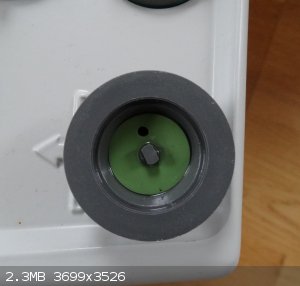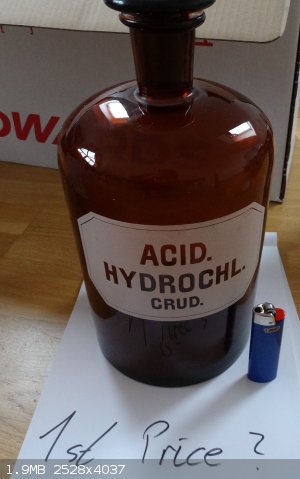
DrScrabs - 29-4-2019 at 06:23
Hello everyone!
So I start a thread about a DIY oil mist filter and really appreciate any helpful answers! Everyone giving answers wich can be found in the filter I
will build gets a appropiate reward like chemicals, glassware or large vintage ground glass bottle(s) 
I got my hands on an fancy Edwards RV3 two stage rotary vane vacuum pump and before I can use it in the lab I have to resolve the oil mist problem. I
dont like a thin oil film in the lab and my lungs!
I checked the prices of a Edwards Oil MIST Filter EMF10 and they are way above 200 bucks. It has the advantage to filter 99.999% of the oil aswell as
returning it to the pump(with an additional piece of hardware? Photo of the gas outlet added, there´s a small hole), minimizing the need to replace
the oil but on the other hand it´s quite expensive (equal to 20l+ of oil).
Checking the Edwards shop I found replacement elements for the filter to be made of fiberglass or PP and had the idea of a DIY solution.
The outlet of my pump is DN25KF so it is easy to mount something on it or to vary the build for any other pump, adapter to DN40KF is also in stock and
I won´t need it.
The main criterias for a DIY unit are:
I. All materials used need to be totally inert to the used oil (Edwards Ultragrade 19 in my case, I did not find a SDS or any information on the
actual oil).
II. No contamination of the oil in any way to not influence the lifespan of the pump [solids and chemical (I.)].
III. Satisfactory efficiency, it should be able to filter at least 99.9% and return all oil wich is not trapped in the filter.
IV. Price and difficulty. It should use cheap OTC material and not exceed the time equal of buying a original one.
V. Max allowed outlet pressure is 0.2 bar for my pump according to the Edwards RV3 datasheet
I add my thoughts I have had till now, maybe they are of interest or just stupid.
First I had the idea to use a stainless steel pipe, bend in a spiral filled with stainless filings lika a column to catch the oil droplets and allow
it to flow back through the spiral. I quickly discarded the idea because of the difficulty of bending a one inch diameter ss tube in a spiral (I have
access to a bending machine of a relative but most others don´t), the amount of the oil wich is held back, the the size and the biggest issure of the
quite high risk of physical contamination due to the the shavings vibrating on the running pump -> they act as little saws on the edges producing
small metal particles wich have to be filtered of again ... unpractical!
So I went online and quickly found this short video on youtube. The way the oil is returned can be optimized and depends on the pump but the general filter seems legit. At least it
brought some new ideas:
Using standart kitchen hood like oil filter material (better alternatives may be OTC aswell) arranged like a flat V in the filter in multiple layers.
The question here is efficiency and if the oil flows back by gravity when the filter layer(s) are saturated.
For other pump types the filters just have to be arranged to collect the oil and use a system similar to the one shown in the video.
There were much more stupid ideas in my head but I´ll keep them there to not blame me too much.
Do you have any idea how to build one or have you done it already?
Can´t wait to read your ideas! Btw I didn´t spent much time online searching 
DrScrabs


Of course I wrote it false on the image. It´s the first prize?
[Edited on 29-4-2019 by DrScrabs]
[Edited on 29-4-2019 by DrScrabs]
Sulaiman - 29-4-2019 at 07:04
I only have a Chinese dual-stage pump but I guess it is similar;
Conceptually, stainless steel wool in a stainless steel funnel would catch most of the mist and return it to the pump,
(a trap or filter would be preferable at the bottom of the funnel to prevent any bits of s/s wool entering the pump)
but it would not be 100% efficient, and it would be VERY NOISY !
Pipe away your semi-filtered fumes to save you from any remaining oil fumes,
and most of the noise, and any undesirable gasses that escaped your scrubber(s) etc.
P.S. my (useful but not great) as-supplied oil filter has a circular weir - presumably to catch heavy particles.
If ferromagnetic (304/A2) s/s is used then maybe a (ring) magnet could be used as an additional trap ?
[Edited on 29-4-2019 by Sulaiman]
RedDwarf - 29-4-2019 at 07:24
How about adapting an air compressor moisture trap ( eg https://www.screwfix.com/p/air-tool-filter-regulator-bsp/310... ) possibly using Sulaiman's idea of adding ss/s wool as well?
DrScrabs - 29-4-2019 at 08:59
@Sulaiman
The general concept is good. But if one has to use a filter anyway, maybe that´s the way to go at all.
Regarding the trap: I didn´t thought about this option yet, good point.
The noise IMHO is not a point of concern, sound surpressing systems for gasses have been well researched in the past, unfortunately for a sad use.
There are plenty of different geometries for pulsating gass impulses (did I got that one right? I mean like gun scilencers, not that much difference I
think). Maybe It´s possible to combine booth, the trap and the scilencer in one device!
Max allowed outlet pressure is 0.2 bar I forgot, sorry, I edited into my original post @V.
@RedDwarf
I have never heard of it, never had anyting to do with compressing air exccept of using it 
Thanks, I will have a look on it. Your link does not work for me the way it is ment to btw, local internet differences haha
DrScrabs - 29-4-2019 at 11:47
Found the best information yet in a pakistan power point presentation as .pdf
It provides a great value of information!
http://www.ncp.edu.pk/docs/iss/talks/Group_I/G1_D4_Dr_Talib....
RedDwarf - 30-4-2019 at 06:29
Another article you might find useful:
https://www.tandfonline.com/doi/pdf/10.1080/1073161X.1994.10...
I'd be tempted to try a small plastic cyclone (just search for cyclone on ebay and you should find the sort of thing I'm thinking about) as the oil
would be less likely to wet the plastic than metal or glass, but I'm thinking that the low (and variable) flowrate might mean that the cyclone just
became a gravitational settlement chamber without the oil particles impinging on the cyclone walls. More esoterically you could look at electrostatic
separation but I suspect in the end you'll come back to fiber filtration as the article says (but perhaps a pe fiber to minimise the amount of oil
hanging around in the filter)
Registration
Ronaldkefdrole - 30-4-2019 at 07:11
Hi!
Can you please advise what is the best way to promote your website?
DrScrabs - 2-5-2019 at 08:54
The articel you linked provides good information, thanks!
My thoughts about a cyclone were the same, I really expect it to be useless here.
Yesterday I visited a friend and he gave me over 20 year old kitchen hood fat filters, they still look good.
I will use them in a first prototype with PE pipes from the hardware store. Still thinking about the arrangement of the filters in the pipe though.
[Edited on 2-5-2019 by DrScrabs]
RedDwarf - 18-12-2019 at 18:04
DrScrabs did you ever decide on a solution (or even more importantly a prize winner!!!). I was reminded of this post when i cam across this:
http://www.hyvac.com/PDFs/Literature/Exhaust%20Filters/Captu...
when browsing recently, not cheap, but might give you some further ideas
beerwiz - 19-12-2019 at 10:27
It's been my experience that even high end oil mist filters are useless. The lab space still gets inundated with oil mist and makes it difficult to
breathe. So I connect a tube to the exhaust and lead it outdoors through a window or you can lead it into the fume hood.
edit: If you try plain old mineral oil from the pharmacy, it really is the best vacuum pump oil to use, no need for the fancy stuff, since this is
better than most vacuum pump oils with almost no oil mist!
[Edited on 19-12-2019 by beerwiz]
XeonTheMGPony - 19-12-2019 at 16:24
https://www.marineengineparts.com/racor-ccv4500-08l-crankcas...
would work great. I was going to order one of these befor dog got injured.
TheMrbunGee - 20-12-2019 at 03:21
I Don't have the knowledge for these things (oil vacuum pumps and consequences), but what about feeding the exhaust in to simple, oil soaked engine
oil filter? Maybe more than one in series. I am really not familiar with this oil mist thing. They are cheap, inert, sturdy, just need to figure out
how to attach it and if it can really collect the mist, then it's perfect!



